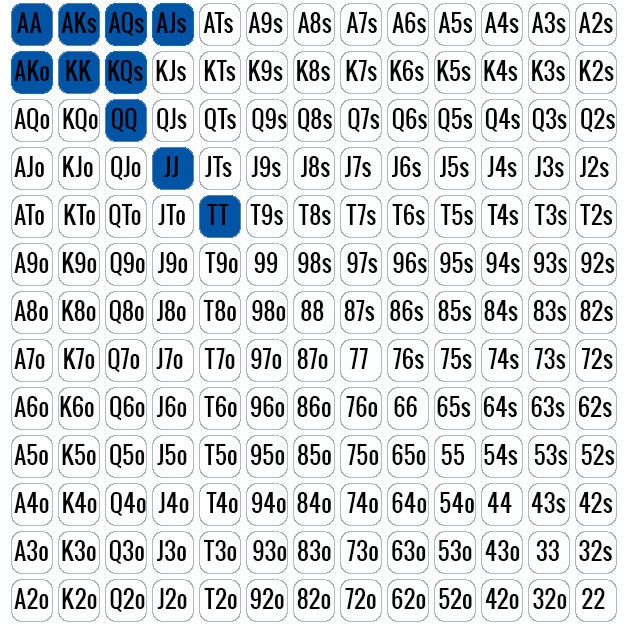Top 10 Poker Hands
The Strongest Poker Hands – Before and After the Flop
Before the flop is dealt, the strongest hands are easy to spot. Aces, Kings and Queens top the list – with Ace-King not far behind.
Bonus Top 10 Best Starting Poker Hands valid for 14 days. 30 Spins on preselected games will be credited instantly + then 30 per day for 9 days. Free Spins valid for 72 hours from credit. Max Free Spins winnings £100. Skrill + Neteller excluded. The 10 Best Starting Hands in Texas Hold 'em Poker. Nick Koudis / Photodisc / Getty Images. A pair of aces, also known as 'pocket rockets' (and sometimes 'American Airlines') is the best. Ace-King (Suited) Ace-Queen (Suited).
The relative strength of poker hands in Texas Hold’em changes as the community cards are dealt. While all sorts of starting hands can hit the flop, there are certain categories which are more likely to turn into hidden monsters.
This page covers the top 10 poker hands, before the flop – and then all the way to the river. This includes:
- Starting Hands: Top 10 hands that every play would love to be dealt before the flop
- Flop Betting: How the first 3 community cards have a huge effect on the ‘relative’ strength of the bet pre-flop hands.
- Turn and River: Draws can complete, or high cards can hit as the community card board is completed.
- Top Hands and Position: Why being dealt a top 10 poker hand alone is not enough to win big.
- How to Tell: If you can spot those times an opponent has a monster hand, you’ll be in a great position top get away from 2nd best holdings.
Starting Hands: The Top 10 Hands Before the Flop
Top Texas Holdem Hands
Pocket Aces rule the rankings before the flop. If you are dealt this hand, you’ll win 80% of the time against any single hand your opponent could hold by the river.
Here are the top 10 hands pre-flop in Texas Hold’em:
- Pocket Aces: There is no better feeling in Hold’em than looking down at a pair of aces. Especially if there has been a raise ahead of you.
- Pocket Kings: With aces so rare, it is usual to assume that your pocket kings are the best hand pre-flop. You can always reassess if you face multiple re-raises. With no aces on the flop, you can hope to win a big pot with this hand.
- Pocket Queens: There is a risk that opponents have aces, kings or ace-king when you are dealt Queens. With no ‘card removal’ for those hands as when you are dealt A-A or K-K. Pocket Queens is still a very strong hand and should be played for a raise.
- Ace-King: This hand is even stronger when suited, though plenty strong enough with just the high card value. If you make a pair on the flop, you will have the top kicker to go with your top-pair.
- Pocket Jacks: As you get down the rankings, even strong starting hands start to become vulnerable to over-cards on the flop. Jacks are often good enough to win unimproved, though you need to be cautious when an ace hits the board.
- Ace-Queen: Again, a suited version is much stronger than an unsuited one – as you’ll be able to make the nut flush on occasion. This hand becomes stronger if your opponents are prone to overplaying aces with weaker kickers.
- Pocket 10’s: This is the last pocket pair which is more likely than not to be an over-pair on the flop. It has hidden value, blocking straights and allowing you to hit a set (as with all smaller pairs) on boards which look ‘safe’ for the higher pairs.
- King Queen Suited: This hand has a lot of potential multi-way. Heads up against one of the premium hands, it does not do as well. If you find yourself with king-queen suited in position in a multi-way pot, you can often make a hidden monster and win a big pot.
- Ace-Jack / Ace-Ten: These hands are vulnerable, though suited versions can make the nut flush, if you don’t make 2 pairs, there is always a chance of a Broadway straight.
- Mid-Pairs: Finally, mid-pairs can make sets – giving them a lot of deceptive strength. When someone has aces, and bets strongly, you can often win their whole stack with a hidden pair or 7’s (for example).
Relative Strength of Poker Hands on Different Flops
Key to success in poker is not to get married to the top 10 starting hands after the flop. There are several factors to consider. While you can often assume that your premium starting hand is still best (and bet it accordingly), a clear assessment of the risks is always useful.
When you see a flop, think about the following:
- How many opponents saw this flop (what is the risk that some random hand connected!)?
- Does this flop have the potential to hit many drawing hands (straights and flushes)?
- Is this the type of flop that will not connect with hands my (tight) opponents are likely to play (low, unconnected flops fit this category)?
- Are there cards on the board which are higher than my pocket pair?
These questions highlight an error that many new players make with premium hands. If you limp or call, instead of raising with those aces – you can end up in a tricky spot. You could see a wet flop (lots of potential draws available) with multiple opponents who might have random holdings. If you have to act first in the betting, the situation looks even trickier. Here your hand is too strong to give up on, though if you get a lot of action on subsequent betting rounds, you could be in trouble!
Playing good hands strongly, and raising a few outside the top 5 for balance, is a great way to avoid too many tough spots on the flop.
Turn and River Cards: How Likely my Opponent Hit?
When the turn or river card completes a flush (for example) and your opponent comes out firing with a big bet, you need to ask yourself how often you are beaten.

The wrong question to ask here is ‘how often do players make flushes by the river?’. You have some additional information. If your opponent called a bet on the flop, or even raised, then they are likely to have some kind of hand. If they continued all the way, only to re-raise you at the end when their card hit – you might just be in trouble.
Getting ‘married’ to over-pairs can be expensive in these situations. What is demonstrates is that even the top 10 starting hands can be losers in certain run-outs. You’ll need to use your judgement to decide whether your opponent might be bluffing in the scenario above. This can be based on the player, their bet sizing in the hand and your history with that opponent. In my experience, players at the smallest stakes are not bluffing frequently enough in this type of spot to make this a profitable call.
Playing the Top 10 Poker Starting Hands in Position

With the dynamics or poker hand strength changing as the community cards come out, playing in position is a great way to optimise your profits. This simply refers to acting last in the betting on the flop, turn and river betting rounds. The player with the ‘Dealer’ button position acts last – though keep in mind that acting last relative to the raiser pre-flop is a different factor.
When you are last to act, you can get away from hands when there is a raise and a re-raise ahead of you. It is always an option to bet out and steal a pot you might otherwise have given up on when everyone checks to you as well.
Position strategy goes a lot deeper than this. When you are starting out, keep in mind that acting last + having a top 10 poker hand is the best spot to be in!
How to Tell If Your Top Hand is Beaten?
As you gain experience playing on different board-textures, and against different types of opponents – spotting those times when your pocket aces are second best becomes a lot easier.

While some opponents keep betting at any pot where they have a piece of the board (or a draw in some cases), other opponents are more cautious. If someone who usually limps and calls suddenly wakes up with big bets, this is a great sign that you could be beaten. I have seen opponents play passively for hours, and suddenly check-raise when they made the top flush. If you pay those types off, it is down to you not paying attention – rather than bad luck.
As many of you know, Phil Hellmuth is one of the most successful Texas Hold 'em players of all time. I recently read his book, Play Poker Like the Pros, and was very impressed with his Hold 'em Strategy. It is not my intent to plagiarize his book, but no poker strategy site would be complete without mentioning the playing ability and strategy of Phil Hellmuth.
Therefore, I have chosen to reveal and comment on what Hellmuth calls his “Top 10.” When Hellmuth refers to his Top 10, he is talking about pocket card, starting hand requirements. One should note that this isn't a list of the only hands Hellmuth plays, but he does suggest that the poker player can make lots of money in low limit poker, by waiting on these cards and playing them aggressively.
Without further ado, Hellmuth's Top 10:
1. A-A
2. K-K

3. Q-Q
4. A-K suited
5. J-J
6. 10-10
7. 9-9
8. 8-8
Top 10 Poker Hands Youtube
9. A-Q suited
10. 7-7
Hellmuth submits that these 10 hands should be the only pocket cards played by the beginner in low limit Texas Hold 'em. This makes the game much simpler before the flop, however, as you can probably guess, the tricks of how to play these 10 hands after the flop can get complicated.
As a general rule though, bet these top 10 hands aggressively. The higher in the ranking, the more aggressively they should be played. Your strategy after the flop will be determined by what hits the board and the actions of your opponents.
Play these top 10 right in low limit Hold 'em games and you will make money. As you build your bankroll and your confidence, you can increase your starting hand requirements.
Meanwhile, I would suggest making a $16 investment in Hellmuth's book, Play Poker Like the Pros. It's not the perfect poker strategy book, and Phil even cautions that he is a no limit player, not a limit player! However, a look inside the mind of a man who has won multiple World Series of Poker bracelets is well worth the $16!